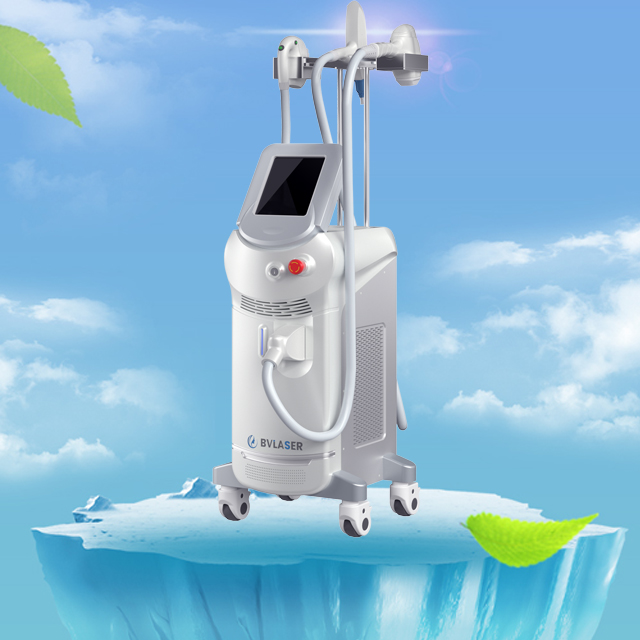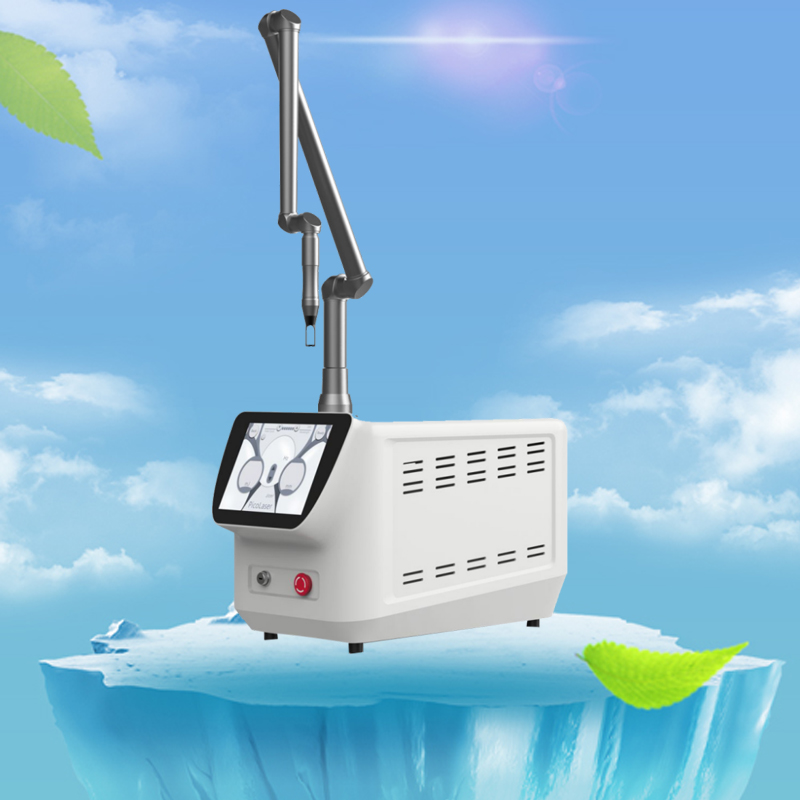What are the main uses of the erbium laser?
Author:baishilf Time:2024-12-10 15:52:55
The Erbium glass fractional fiber laser 1550nm machine is a type of laser used for skin resurfacing. It can be used to treat pigmentation, acne scarring, wrinkles and imperfections or to improve skin texture. It evaporates the tissue on the skin’s surface to reveal a brand new skin surface underneath.

The erbium glass laser emits a wavelength of 1550 nanometres (nm). This laser wavelength is primarily attracted to the water in the skin. This attraction to water causes controlled ablation of a very fine layer of skin. This laser can therefore be used to resurface the skin and help to reduce wrinkles, acne scarring, and pigmentation. The laser can also be used to remove various skin lesions (skin lumps and bumps). Water is a primary constituent of the skin and the erbium laser has an extremely high affinity to the water in the skin. Therefore, as soon as the erbium laser energy reaches the skin, it immediately vaporises the skin on contact due to its high affinity to the water in the skin. The erbium laser has a very shallow penetration depth, as once it hits the skin’s surface the energy is immediately absorbed by the water in the skin. Therefore there’s very little heat energy transmitted to the deeper layers of skin.
In comparison, the CO2 laser is also attracted to the water in the skin, but not as strongly as the erbium laser. Therefore, some of its energy continues to penetrate deeper into the skin’s surface, as not all of the energy is absorbed immediately in the top layers. This deeper heating of the skin leads to tissue tightening and contraction, something that is not seen with the erbium laser. When resurfacing skin, often a combination of the two lasers are used to exploit both their properties.
What are the main uses of the erbium laser?
As the erbium laser resurfacing is used to remove very fine layers of the skin, it is used primarily to resurface skin for.
*Wrinkle reduction
It is possible to resurface wrinkles by inducing new collagen and skin regeneration by ablating a very fine layer of skin with each pass of the erbium laser. The greater the number of passes, the deeper the resurfacing of the skin, the longer the recovery period, and the better the results. Recovery from laser skin resurfacing with the Erbium usually takes 1 to 2 weeks.
*Treatment of acne scarring
The erbium laser can be used in the treatment of atrophic (indented) acne scars. By ablating the superficial layers of the skin, new collagen and skin is regenerated, and the skin tends to return with a more even texture.
*Pigmentation
The erbium laser can also be used to treat pigmentation on the skin by removing the top layers of the skin where the pigmentation resides. Pigmentation treatment is not usually performed with the erbium laser unless it is done in conjunction with skin resurfacing for wrinkles. The downtime/recovery is longer than other lasers such as the PiQo4 or ruby lasers that can remove pigment more specifically with less downtime and without having to remove layers of the skin.
*Removal of skin lesions
The erbium laser can be used to remove skin lesions that may be better suited to removal with laser rather than surgical excision. For example, various skin tags, solar keratosis, and benign nevi c can be treated. It is not suitable for the removal of melanoma.
*Treatment rhinophyma
Rhinophyma is a condition that leads to sebaceous gland enlargement on the nose and a bulbous nose. It is associated with a condition called rosacea. The erbium laser can help to remove these excess tissues on the nose and return it to its normal size and shape.

What is involved with erbium laser treatment?
#Consultation
A consultation with doctors is the first step to assess if you are a suitable candidate for erbium laser treatment. Depending on the skin type, you may require preparation with certain skin care products such as topical retinoids or hydroquinone for a month or two to help flush out excessive skin melanin and even out skin thickness to reduce the incidence of possible complications such as post-inflammatory hyperpigmentation or an uneven response to the laser.
#During the procedure
The patient will be required to arrive 1 hour before the procedure, and it will usually be performed in a doctor’s clinic. The patient will be given both topical and local anaesthetic, and the topical anaesthetic will be applied for 1 hour beforehand. The doctor will thoroughly clean the patient’s face with medical grade acetone before starting the laser treatment.
#After the procedure
After the erbium laser treatment, the area will need to be kept clean and dry. An ointment may be administered immediately after the procedure, but other than that you should not apply anything. You can apply ice or moisturiser 6-8 hours after the procedure. Your skin may be slightly red and swollen for the first few days after treatment. Try to avoid causing any irritation from clothes or towels as much as possible.
What to Expect During the Erbium Laser Procedure
Erbium lasers stimulate the body’s natural healing process, triggering the growth of healthy new skin cells. Erbium laser treatment under a local or topical anesthetic to prevent you from feeling any pain during the procedure.
How long the procedure takes depends on the areas you are having treated. If you are having only parts of your face treated, the procedure may only take 30 minutes to complete. Full face treatments can take up to 2 hours to complete and may be done under sedation. Doctor will discuss your expectations in detail before your treatment.
Who is suitable for erbium laser treatment?
The erbium laser is suited for resurfacing skin on people who have mild to moderate wrinkles, sun damage, or acne scarring. It is best suited to fairer skin types. Those who have darker skin types are more likely to have complications from treatment. It is not suited to those who are pregnant or breast-feeding or who have a history of keloid scarring.
If you are unhappy with your appearance because of wrinkles and textural problems but you do not want to undergo surgery, consider Erbium laser skin resurfacing. You are considered a good candidate for erbium laser resurfacing if you are seeking treatment for:
*Scars.
*Uneven pigmentation.
*Birthmarks.
*Liver spots/age spots.
*Lines and wrinkles under/around eyes, forehead, and mouth.
*Skin that has been damaged by the sun.
What are the side effects/risks of erbium laser treatments?
*The erbium laser, when used for skin resurfacing, usually takes approximately 1 to 2 weeks to recover from. The skin usually appears red, swollen, and then crusts over this period. There may be some residual redness that can persist for 1 to 2 months in some cases, depending on the severity of the treatment.
*Infection with the herpes (the cold sore virus) or bacterial infection are possible after erbium laser resurfacing, and prophylactic medication for these conditions needs to be taken before and after treatment.
*There is a small risk of skin pigment changes after erbium laser treatments. Especially if the patient’s skin type is olive or darker, the risk of hyperpigmentation (increased skin pigmentation) or hypo-pigmentation (decreased skin pigmentation) is possible. Hence, we usually restrict erbium laser treatments to those with lighter skin types.
*Rarely, scarring can occur with erbium laser treatments. This occurs when the depth of the resurfacing/treatment exceeds a level where the skin is able to regenerate completely.
*Acne eruption is possible as a result of any ointments that may be used for healing, but should only be temporary.
FAQ
#How many treatments will you need?
The Erbium laser performs intensive laser resurfacing, so one treatment is usually enough to achieve results.
#How long do Erbium laser results last?
This will vary from person to person, but the results of the procedure can last up to 12 months or more, especially if the patient follows the skincare regimen recommended to them by their clinician.
#How long does it take for the face to heal after Erbium laser treatment?
This will depend on the intensity of the treatment, and on whether or not the Erbium laser has been performed on your full face. The redness you experience after the procedure may last for up to 3 weeks. Your doctor will advise you on how to care for your skin during this period.
#How much does the Erbium laser cost?
The price of the Erbium laser treatment will depend on how much of your face is being addressed by the procedure and a quote will be provided at your consultation.
Recovery
It will likely take you 1 to 2 weeks for the treated area to heal following your procedure. You may notice some mild irritation and peeling. Avoid touching or scratching at your face to ensure proper healing. Make sure to keep your skin moisturized to soothe discomfort while recovering.
Mild pinkness of the skin may persist for several weeks even after initial healing is complete. Fortunately, these pink areas can easily be camouflaged with makeup. Over time, your skin will become tighter and wrinkles will smooth out for a healthy, youthful appearance. Doctor will create a plan for you to follow as you recover from your erbium laser treatment.






















